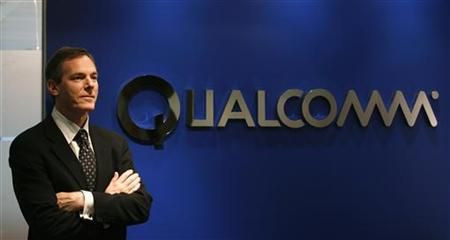Qualcomm vs. Intel: Challenger Starts Major Push To Be No. 1
Qualcomm's Rise: Riding Mobile Chip High Tide

It doesn't look like a mistake: In the fourth quarter of 2012, the market value of Qualcomm Inc. (NASDAQ:QCOM), the No. 1 designer of mobile chips, exceeded that of Intel Corp. (NASDAQ:INTC), the No. 1 chipmaker, for the first time.
At the close of Wednesday trading, Qualcomm, of San Diego, was valued at $110.6 billion, about $3.5 billion more than Intel, of Santa Clara, Calif., the company whose explosive growth will be forever linked to the era of the PC.
Former Intel CEO and Chairman Gordon E. Moore, a legendary electrical engineer, is the inventor of “Moore’s Law,” which stipulates the power of a microprocessor doubles roughly every 18 months. His successor, Andrew S. Grove, a legendary chemical engineer, ran the business with the mantra, “Only the paranoid survive,” which became the title of his memoir.
Now, Qualcomm looks to be ascending while Intel appears descending. On Monday night, CEO Paul E. Jacobs, 50, gave the keynote address at the International Consumer Electronics Show, during which he unveiled the second generation of Qualcomm’s Snapdragon processor, which has been designed into hundreds of mobile products, from smartphones to ultralight laptops, mainly from Asian manufacturers, including Lenovo Group (PINK:LNVGY), the No. PC maker that's also moving into smartphones.
Since Apple (NASDAQ:AAPL) first started selling the iPhone in 2007, there’s been a Qualcomm chip inside, too. Ditto for the iPad and the newer iPad Mini series.
Last year, Intel CEO Paul Otellini, gave a keynote in which he hailed the Ultrabook series of ultralight chips, which shipped late in 2012. So far, they haven’t made much of a dent in Intel’s performance. Moreover, Otellini, 62, announced his sudden retirement this year, leaving Intel without a designated successor.
To be sure, Qualcomm’s Jacobs had it easier: His father, Irwin, now 79, founded the company in 1985. Irwin Jacobs, a professor of electrical engineering, founded Linkabit, a forerunner of what’s now M/A-Com Technology Solutions Holdings (NASDAQ:MTSI), in 1968.
The younger Jacobs, who has a doctorate in electrical engineering and computer science from the University of California, Berkeley, started out designing mobile chips at Qualcomm not long after Irwin started it.
From the start, Qualcomm exploited high-growth markets in mobile communications, just as the technology got deployed in the U.S. after successful launches in Europe and Asia. Qualcomm essentially invented the CDMA standard that was the foundation of the major U.S. networks headed by Verizon Wireless, majority owned by Verizon Communications Inc. (NYSE:VZ).
Unlike Intel, the company kept its capital costs low by not building its own semiconductor plants. That meant close contacts with Asian manufacturers such as Samsung Electronics (KSX:005930) and Taiwan Semiconductor Manufacturing Co. (NYSE:TSM) that helped with market intelligence.
With hindsight, it may have been those connections that allowed Qualcomm to ride the shift to mobile platforms that become apparent last year and is expected in surge in 2013 and beyond. In 1999, Jacobs Sr. pushed the company out of marketing its own mobile phones, when it couldn’t keep up with competition from Nokia Oyj (NYSE:NOK), the old Motorola Inc. and Ericsson (NYSE:ERIC).
So for more than a decade, Qualcomm has concentrated solely on designing new products, selling the chips as well as licenses. Jacobs Jr. took over as CEO in July 2005.
Since then, shares of Qualcomm have gained more than 90 percent. By contrast, in the same period, shares of Intel have lost 19.2 percent. It's probably no accident that of the 45 analysts who cover the company, 40 have either "strong buy" or "buy" recommendations on the shares.
Despite its huge patent portfolio, the chip designer under Paul Jacobs has also moved shrewdly. It has strong licensing deals with ARM Holdings (NASDAQ:ARMH) of the UK, another crucial Apple mobile partner. In May 2011, Qualcomm paid $3.1 billion to acquire Atheros Communications, another fabless chip designer, which had innovative designs for tablets and the so-called “smart home.”
Qualcomm continues to generate a torrent of cash, too. In the fourth quarter ended Sept. 30, cash and investments were $26.84 billion, compared with $20.9 billion a year earlier. Net earnings rose to 89 cents a share from 80 cents a year earlier as revenue jumped 13 percent to $4.87 billion.
“Pretty soon, mobile connections are going to outnumber us,” Jacobs said at CES on Monday, noting there are at least 6.4 billion mobile connections worldwide, about the same as the global population.
Not only will wireless connections speed communications and entertainment, he said, they’ll also be the heart of a revolution in medicine, where patients have pacemakers communicating directly with the physicians, or consumers working out on the treadmill will be able to send their daily workout results to the cloud.
Qualcomm looks as if it will be riding the new wave. Can Intel catch up?
© Copyright IBTimes 2024. All rights reserved.






















